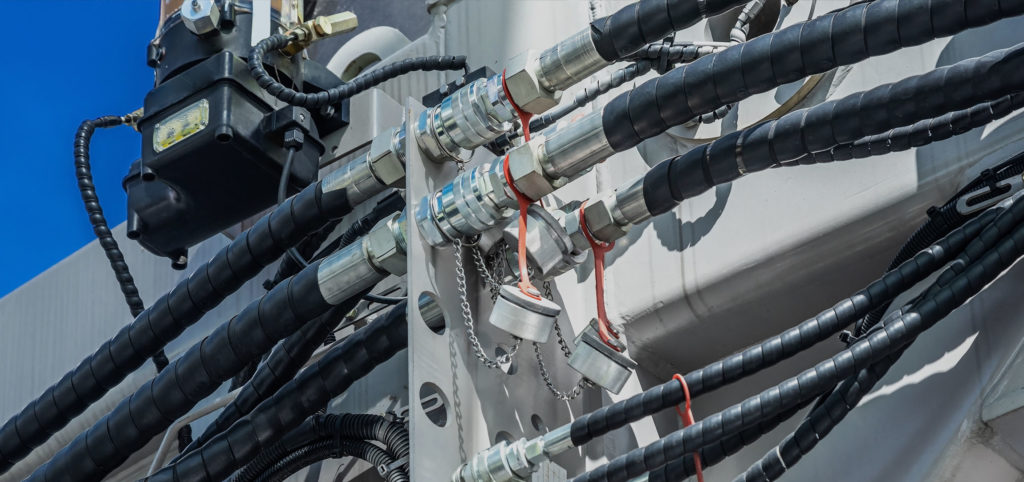Hydraulic System Calculations: Key Formulas for Improved Performance
/ 2
From manufacturing to construction, hydraulic systems are a key component across a multitude of industries.
With such importance on their performance, understanding necessary hydraulic calculations is vital to avoid unnecessary downtime, inefficient operations, and equipment failure.
Fluid Pressure (P): Understanding System Force
Pressure is a crucial factor in all hydraulic systems, representing the force exerted per unit area. Ensuring proper system pressure means your system operates with safe and efficient parameters.
Formula: P=FAP=AF
Where:
- PP = Pressure (PSI)
- FF = Force (Pounds)
- AA = Area (Square Inches)
Fluid Flow Rate (Q): Measure Fluid Volume
The flow rate measures the volume of fluid passing through a point per unit time and helps you to ensure the right amount of fluid is passing through.
Formula: Q=VTQ=TV
Where:
- QQ = Flow Rate (GPM)
- VV = Volume (Gallons)
- TT = Time (Minutes)
Fluid Power (Horsepower – HP): Improving Efficiency
Hydraulic systems rely on pressure and flow rate and so calculating horsepower allows you to gauge how much power there is for your system without overloading it.
Formula: HP=P×Q1714HP=1714P×Q
Where:
- HPHP = Horsepower
- PP = Pressure (PSI)
- QQ = Flow Rate (GPM)
Cylinder Area (A): Calculate Piston Surface Area
The area of a cylinder’s piston determines the force it can create, helping you to calculate how much force may be required for certain tasks.
Using Radius: A=π×R2A=π×R2
Using Diameter: A=π×D24A=4π×D2
Where:
- AA = Area (Square Inches)
- RR = Radius (Inches)
- DD = Diameter (Inches)
Cylinder Force (F): Determine Exerted Force
The force exerted by a hydraulic cylinder has to be calculated to make sure the cylinder can handle the required load of the system.
Formula: F=P×AF=P×A
Where:
- FF = Force (Pounds)
- PP = Pressure (PSI)
- AA = Area (Square Inches)
Cylinder Speed (v): Control Movement Speed
Cylinder speed controls how quickly pistons move and so the calculations are essential for optimising the timing of hydraulic systems.
Formula: v=0.3208×QAv=A0.3208×Q
Where:
- vv = Velocity (Feet per Second)
- QQ = Flow Rate (GPM)
- AA = Area (Square Inches)
Pump Output Flow (Q): Controlling Flow
Control the flow of hydraulic fluids using the below calculation to maintain correct pressure and rate of flow.
Formula: Q=n×d231Q=231n×d
Where:
- QQ = Flow Rate (GPM)
- nn = Speed (RPM)
- dd = Displacement (Cubic Inches per Revolution)
Pump Input Horsepower (HP): Pump Efficiency
Calculate the horsepower required to drive a pump to control flow rate and pressure and minimise energy waste.
Formula: HP=Q×P1714×EHP=1714×EQ×P
Where:
- HPHP = Horsepower
- QQ = Flow Rate (GPM)
- PP = Pressure (PSI)
- EE = Efficiency (Decimal Form)
Fluid Motor Torque (T): Motor Performance
Accurate torque calculations help you choose the motors that can handle the required load without compromising performance.
Formula: T=P×d6.2822T=6.2822P×d
Where:
- TT = Torque (Inch-Pounds)
- PP = Pressure (PSI)
- dd = Displacement (Cubic Inches per Revolution)
Understanding Hydraulic Calculations
Get in touch with Fluid Power Services today to review your hydraulic operations and improve your existing system’s performance.


